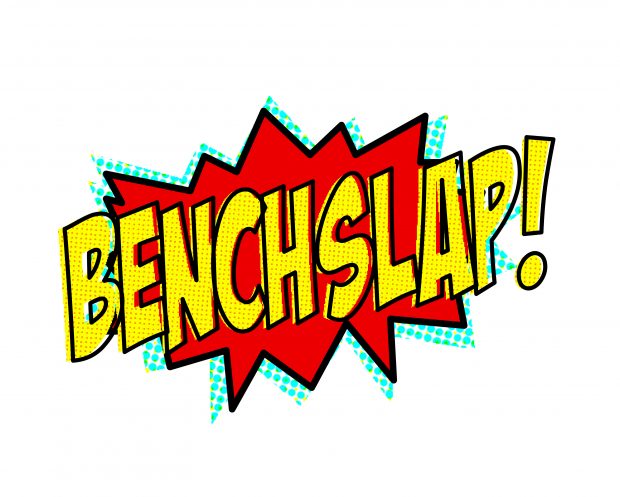
Back in May, Butler Snow received a particularly irate order to show cause. The firm represented the Alabama Department of Corrections in case where an inmate was stabbed 20 times — not 20 times in one sitting, 20 different times — and the inmate objected to the timing of a proposed deposition noting that the Corrections filing “appears to have fabricated citations to legal authority in his motion for leave, ‘possibly through the use of generative artificial intelligence,'” as the order explained.
Judge Anna Manasco just issued her decision on this one and it’s 51 pages of hot fire.
When the dust settled, three attorneys — two partners and an of counsel — earned a public reprimand, got disqualified from the case, and referred to the state bar. The court also went out of its way to release without sanction the associates on the case and the firm itself. In a profession where accolades accumulate at the top and responsibility gets pushed downhill, it’s refreshing that the associates who declared that they had nothing to do with the fake citations inserted by a partner avoided punishment for being dragged along for the ride.
A new trend in AI hallucination cases is the “wrong case, right law” phenomenon. While some cases involve entirely false statements of law, more and more we’re seeing the algorithms inventing fake captions to support otherwise correct statements of law. ChatGPT’s basically trying out for Law Review and refuses to cite one case when it could throw in 20. When caught in a hallucination, lawyers in this situation have clung to the “no one was really misled” argument. Judge Manasco is unpersuaded:
At the threshold, the court rejects the invitation to consider that actual authorities stand for the proposition that the bogus authorities were offered to support. That is a stroke of pure luck for these lawyers, and one that did not remediate the waste and harm their misconduct wrought. Further, any sanctions discount on this basis would amplify the siren call of unverified AI for lawyers who are already confident in their legal conclusion. This court will have no part of that.
Nor did the judge appreciate the “we’ve suffered enough” argument:
Likewise, the court rejects the invitation to consider that the involved lawyers and firm have been deeply embarrassed in media reports. For many very good reasons, courts traditionally have not relied on the media to do the difficult work of professional discipline, and this court is not about to start.
As a representative of the media who often finds himself meting out professional ridicule, this is a good standard.
Recently, I’ve been making the argument that slap-on-the-wrist punishments made sense in the infancy of ChatGPT, but in 2025, there’s no excuse for anyone continuing to make the same old mistakes. At least find new and interesting ways to make mistakes. Like, say you put the right cases in but then an “Agentic tool” overrode them. There are so many ways to be negligent without being reckless!
To that point, Judge Manasco feels we’ve very much crossed into reckless territory:
The court has no difficulty finding that Mr. Reeves’s misconduct was more than mere recklessness. In the light of repeated general warnings from federal courts about the risks of bogus citations generated by AI, as well as the persistent specific warnings, policies, and expectations of his colleagues and law firm with respect to AI, Mr. Reeves’s misconduct was particularly egregious. Having been so extensively alerted of the risk that AI will make things up, and having blown through all of his firm’s internal controls designed to protect court filings from counterfeit citations, Mr. Reeves’s repeated decisions to parrot citations generated by AI without verifying even one of them reflect complete and utter disregard for his professional duty of candor. This is recklessness in the extreme, and it is tantamount to bad faith. Accordingly, the court will impose an appropriate sanction under its inherent authority.
While Reeves inserted the cases, the judge had more issues with the rest of the senior team. Breaking down the order on social media, Kathryn Tewson wrote, “I would describe the court’s commentary about how little effort Mr. Cransford would have needed to expend to prevent this disaster as ‘withering,’” and that’s an apt description.
This misconduct was more than simple recklessness and is particularly egregious, especially in the light of how little effort would have been required of Mr. Cranford to uncover any of the falsehoods. The unacceptable result of Mr. Cranford’s decisions is that motions were filed with the court that no attorney ensured were free from false statements. Attorneys who sign motions must know — as Mr. Cranford
acknowledges — that they risk serious sanctions when they make no effort to ensure that those motions tell the truth. Accordingly, the court finds that Mr. Cranford’s misconduct was tantamount to bad faith and will sanction him under its inherent power.
The court refers to “its inherent power” because, apparently, Rule 11 doesn’t actually apply to discovery motions. Which seems… like a weird oversight.
Arguably the harshest criticism fell upon the final attorney, William Lunsford, who both works at Butler Snow and “holds the designation of deputy attorney general” for the state of Alabama. Lunsford first “troubled the court” by immediately asking to be excused from the order to show cause — that was denied — and then explained that his “name and signature appear on all of the current public contracts for
professional services provided by outside legal counsel to the State of Alabama (the “State”) on a limited number of matters for which the State elects to hire outside counsel.” Seemingly making the argument that, as part of the deputy attorney general role, he’s just the figurehead on these filings.
Guess who was not amused…
Both before and at the show cause hearing, Mr. Lunsford deepened rather than allayed the court’s concerns about his understanding of his professional responsibility with respect to court filings that bear his name in the signature block.
Oof. The order explains that Lunsford told the court that he didn’t know about the use of AI because these cases “often involve similar facts and law, when the team he leads has a need for legal research in a case, it is their ordinary practice to re-use (apparently without verification) material from filings in other cases.” Which… yeah, that happens in well-tread areas of law, but you still at least take a look. Also, the fact that the caselaw supporting “the state doesn’t care if inmates get stabbed 20 times” is so established that it earns such blasé treatment should be a deeper red flag about how we treat our prisons.
After describing Lunsford’s actions as “particularly egregious, more than mere recklessness and tantamount to bad faith,” Judge Manasco went nuclear:
To be clear, the court’s finding in this regard is not simply a harsh inference: when it became apparent that multiple motions with his name in the signature block contained fabricated citations, Mr. Lunsford’s nearly immediate response was to try to skip the show cause hearing and leave the mess for someone else. And when the court compelled him to appear at the hearing, he paired his apology with an
explanation in greater fullness of how very little work he personally puts in to be sure that his team’s motions tell the truth. This cannot be how litigators, particularly seasoned ones, practice in federal court or run their teams.
I would simply curl up and poof out of existence if this were written about me.
I’ve been bemoaning the unwillingness of courts to pull out sanctions with teeth — Judge Manasco heard that call. In any event, she reminds us all that the thing about a disincentive is that it actually has to disincentivize something:
Having considered these cases carefully, the court finds that a fine and public reprimand are insufficient here. If fines and public embarrassment were effective deterrents, there would not be so many cases to cite. And in any event, fines do not account for the extreme dereliction of professional responsibility that fabricating citations reflects, nor for the many harms it causes. In any event, a fine would not rectify the egregious misconduct in this case.
Emphasis added because it cannot be emphasized enough.
(Order on the next page…)
Earlier: Am Law 200 Firm Slapped With Order To Show Cause Over Fake Citations… You Know Where This Is Going
Law Firm Tagged Over Fake Citations Quietly Deletes Blog Post Encouraging Lawyers To Use AI
 Joe Patrice is a senior editor at Above the Law and co-host of Thinking Like A Lawyer. Feel free to email any tips, questions, or comments. Follow him on Twitter or Bluesky if you’re interested in law, politics, and a healthy dose of college sports news. Joe also serves as a Managing Director at RPN Executive Search.
Joe Patrice is a senior editor at Above the Law and co-host of Thinking Like A Lawyer. Feel free to email any tips, questions, or comments. Follow him on Twitter or Bluesky if you’re interested in law, politics, and a healthy dose of college sports news. Joe also serves as a Managing Director at RPN Executive Search.